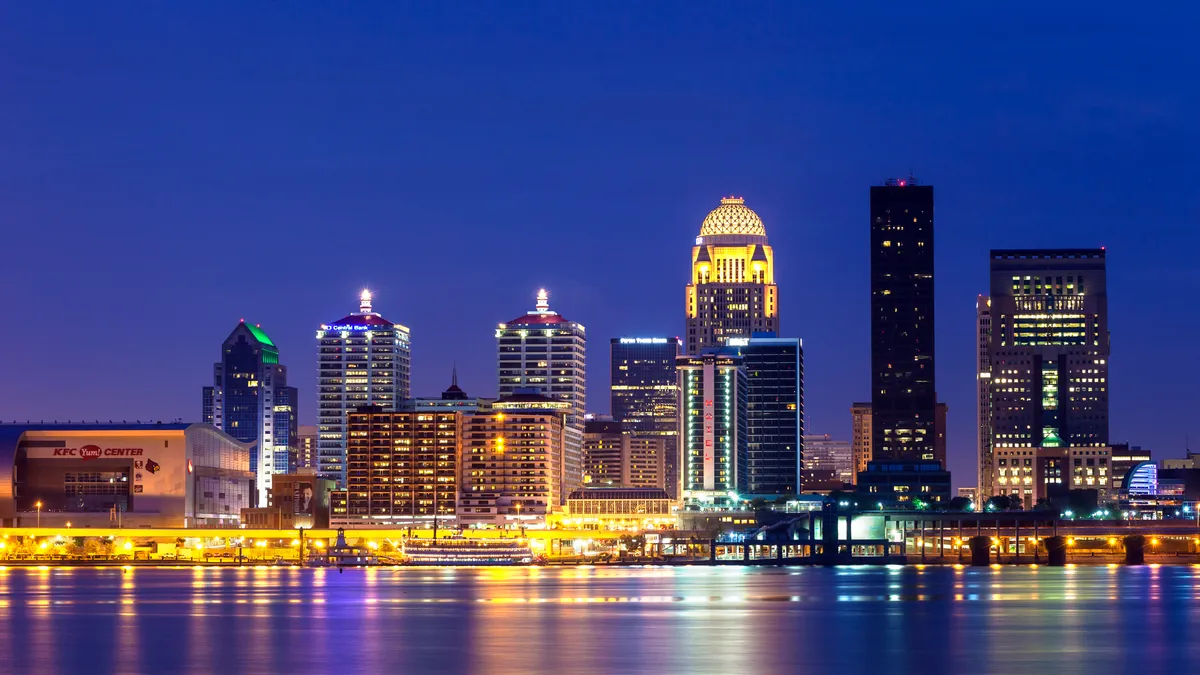Dive Brief:
- Louisville, Kentucky, leaders are exploring whether the city could form a new municipal utility to bring electricity to city buildings in a bid to meet its climate goals.
- The city has a goal of 100% clean energy to power government buildings by 2030 and to reach the entire community by 2040. City officials are concerned that Louisville Gas and Electric Co. (LG&E), the current service provider, relies too heavily on fossil fuel generation to support that goal, said Allison Smith, assistant director at Louisville’s Office of Advanced Planning and Sustainability.
- After consulting with the National Renewable Energy Laboratory, Louisville issued a request for proposals seeking a feasibility study on how the city could power municipal buildings or a small subset of such buildings without LG&E. Smith said the options could include the city building its own infrastructure to connect to an interstate transmission system or expanding renewable generation in the city.
Dive Insight:
More than 2,000 communities have formed their own public power utilities, a step that offers governments and citizens more direct control over their electricity generation and policy. Ursula Schryver, vice president of strategic member engagement and education for the American Public Power Association, said the process allows a local community to focus on its priorities, like lowering costs or changing the energy mix rather than being beholden to a shareholder-driven utility. This has become especially important as local governments ramp up their renewable energy and climate commitments, which set benchmarks that investor-owned utilities sometimes struggle to meet.
“If sustainability is the focus of the city, that would be the focus of the [municipal] utility,” said Schryver. “Municipalization means there is not a corporate headquarters somewhere else. The utility will be run by an appointed board. That allows the city to determine what their goals will be.”
According to an energy dashboard for the Louisville metro area, electricity provider LG&E gets 60% of its power from coal, 37% from natural gas, 3% from hydroelectric sources, and less than one-tenth of 1% from solar. The utility’s recent long-range plan, issued in July 2020, said that while LG&E is adding solar generation and hydropower, it also plans to continue burning coal. It forecasts an emission reduction of between 22% and 47% from 2010 levels by 2035.
Louisville’s Smith said that creates a “mismatch” with the city’s priorities.
“We knew we would have to go outside of LG&E to do this,” Smith said. The city has worked with the utility on a green tariff option that would allow electricity buyers to choose renewable energy suppliers that is distributed on LG&E’s transmission lines. Smith noted that the review process is in its early stages and will consider a variety of factors, including reliability, energy efficiency and especially cost.
“We’re talking about taxpayer funds … and we don’t want to increase the cost of utilities,” Smith said.
Critics have long warned that municipalization comes with the potential for increased costs and disruptions in service during the transition period. A 2019 report from consulting firm Concentric Energy Advisors found that many new municipal operations lack the scale and diversity of resources of larger investor-owned utilities, which can lead to higher costs in a storm or similar one-time event. It also found that the up-front costs of acquiring new equipment and service can often exceed early estimates.
LG&E did not respond to requests for comment.
Concerns about electricity costs, reliability and climate impacts have prompted more cities across the U.S. to consider municipalization. El Paso, Texas’ public electricity provider kept the power on for its residents during last year’s Winter Storm Uri, even as most of the state's providers had to cut electricity, in large part because it invested in greater winterization of its power plants after a similar storm in 2011.
Boulder, Colorado, notably went through a decade-long process of exploring municipalization because of concerns about electricity provider Xcel Energy’s climate impact. Although the city did not end up forming a public utility, a significantly greater proportion of Xcel's electricity now comes from renewable energy than when the city began that exploration in 2010. Large cities including San Diego, San Francisco and Chicago also have explored municipalization. San Diego has taken the interim step of advancing a community choice aggregation plan that will allow the city to purchase clean electricity on the market. A spokesman for the city of Chicago said that the city’s review is still going through “internal deliberation.”
Even going through the review process — as Louisville is doing — can be instructive and can allow a city to exercise more power over the utility, Schryver said. Only 18 cities have formed their own public power organizations in the last 20 years, she added.
“It’s not for everyone, but it is worth exploring,” she said. “Very often, the result is some sort of agreement where the utility finds a way to meet the city’s goals. It’s an opportunity to identify a community’s priorities and emphasize their importance."















